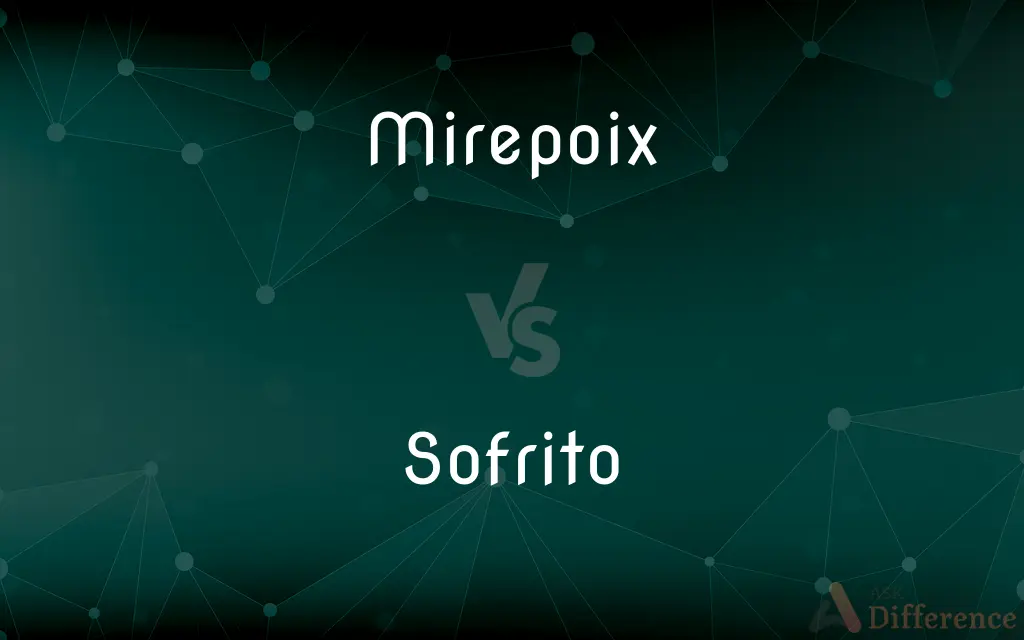Mirepoix vs. Sofrito — What's the Difference?
By Urooj Arif & Fiza Rafique — Updated on March 26, 2024
Mirepoix is a French culinary base made of diced carrots, celery, and onions, used to add flavor to dishes, while sofrito is a Latin American, Spanish, and Italian base that includes garlic, onions, peppers, and tomatoes.

Difference Between Mirepoix and Sofrito
Table of Contents
ADVERTISEMENT
Key Differences
Mirepoix serves as a foundational flavor base in many French dishes, consisting of a mix of onions, carrots, and celery, usually chopped and cooked in butter or oil. On the other hand, sofrito is a versatile aromatic base used in Spanish, Latin American, and Italian cuisines, typically including garlic, onions, peppers, and tomatoes, with variations according to regional preferences.
While mirepoix is often associated with more traditional, slow-cooked recipes, sofrito is used in a broader range of dishes, including rice dishes, stews, beans, and sauces, showcasing its adaptability across various cuisines. Mirepoix's flavors are generally more subtle and are meant to enhance the main ingredients without overpowering them. Conversely, sofrito can be more pronounced, contributing a distinctive taste and aroma that is recognizable in many dishes across Spanish and Latin American cuisines.
Another key difference lies in their preparation and application. Mirepoix is usually cooked at the beginning of the recipe to create a flavor foundation, with its components often removed before serving. Sofrito, while also used early in cooking, can be added during different stages of the cooking process and may be more visible and integral to the final dish, reflecting a blend of cultural influences and culinary techniques.
The concept of mirepoix is relatively standardized, whereas sofrito can vary significantly from one region to another, incorporating additional ingredients like cilantro, bell peppers, and a variety of spices, reflecting the diverse culinary traditions and local tastes of its regions.
Comparison Chart
Ingredients
Carrots, celery, onions.
Garlic, onions, peppers, tomatoes (variations exist).
ADVERTISEMENT
Origin
French
Latin American, Spanish, Italian
Cooking Method
Sautéed slowly in butter or oil.
Finely chopped and sautéed in oil.
Flavor Profile
Subtle, meant to enhance main ingredients.
Distinctive, can define a dish's flavor.
Usage
Base for soups, sauces, stews.
Used in rice dishes, stews, beans, sauces.
Variability
Standardized
High regional variability
Visibility in Dish
Often removed before serving.
Integral to the final dish.
Compare with Definitions
Mirepoix
A culinary staple in French cuisine for flavoring soups, stews, and sauces.
Adding a mirepoix is my secret to a flavorful chicken broth.
Sofrito
Varied by region, incorporating local ingredients and tastes.
In Puerto Rico, sofrito is made with ajíes dulces and recao.
Mirepoix
Represents the basic foundation of French cooking.
Learning to make a proper mirepoix is essential in French culinary schools.
Sofrito
A flavorful blend of garlic, onions, peppers, and tomatoes, foundational in many Latin American and Spanish dishes.
The sofrito added a rich base to the paella's complex flavors.
Mirepoix
A mixture of chopped celery, onions, and carrots used as a base for many French dishes.
The chef prepared a mirepoix for the beef bourguignon to ensure a rich flavor.
Sofrito
Used as a starting point for cooking, adding depth to dishes.
Every good stew starts with a freshly made sofrito.
Mirepoix
Used to enhance the complexity of flavors in dishes.
The mirepoix was cooked slowly to blend its flavors into the sauce seamlessly.
Sofrito
A method to introduce a burst of flavor at any cooking stage.
Adding extra sofrito towards the end of cooking can enhance the dish's aroma.
Mirepoix
A combination of vegetables sautéed as the first step in many recipes.
Start the soup by cooking a mirepoix in butter until soft.
Sofrito
Integral to the cuisine's identity, often visible in the final dish.
The sofrito in the rice not only adds flavor but also a vibrant color.
Mirepoix
A seasoning composed of finely diced sautéed vegetables and herbs and sometimes diced ham, bacon, or salt pork.
Sofrito
Sofrito (Spanish, pronounced [soˈfɾito]), sofregit (Catalan), soffritto (Italian, pronounced [sofˈfritto]), or refogado (Portuguese, pronounced [ʁɨfuˈɣaðu]) is a basic preparation in Mediterranean, Latin American, Spanish, Italian and Portuguese cooking. It typically consists of aromatic ingredients cut into small pieces and sautéed or braised in cooking oil.
Mirepoix
A combination of diced onions, carrots, celery and herbs sautéed in oil or butter as used in French cooking.
Sofrito
A sautéed mixture of seasonings and finely chopped vegetables, such as onions, garlic, and peppers, used as a base for many Spanish, Caribbean, and Latin American dishes.
Mirepoix
(figurative) A mixture.
Sofrito
(cuisine) A sautéed mixture of chopped onions, garlic, and tomato and/or (chili) peppers, and sometimes carrots, celery, and/or herbs, used as the beginning point of a dish, especially in Hispanic or Portuguese cuisine.
Common Curiosities
What is the primary use of mirepoix and sofrito in cooking?
Mirepoix is used as a flavor foundation in French cooking, while sofrito serves a similar purpose in Latin American, Spanish, and Italian cuisines, with each adding depth and complexity to a variety of dishes.
How do the cooking methods of mirepoix and sofrito differ?
Mirepoix is usually cooked slowly to gently release its flavors, while sofrito is often sautéed more quickly to maintain its boldness and character.
Is sofrito always spicy?
Not necessarily; the spice level of sofrito can vary greatly depending on the types of peppers used and regional preferences.
What makes sofrito different from mirepoix in terms of ingredients?
Sofrito typically includes garlic, peppers, and tomatoes, offering a more robust and varied flavor than the more subtly flavored mirepoix of carrots, celery, and onions.
Can mirepoix or sofrito be used interchangeably in recipes?
While they serve similar foundational purposes, their distinct flavor profiles mean they are not directly interchangeable but can be adapted based on the desired outcome of a dish.
In which dishes is sofrito commonly used?
Sofrito is commonly used in dishes like rice, beans, stews, and sauces, providing a flavorful base that defines many Latin American and Spanish recipes.
What are some key differences in preparation between mirepoix and sofrito?
The preparation differences lie mainly in the ingredients used and the cooking techniques, with mirepoix being cooked slowly to meld flavors gently and sofrito often cooked more quickly to highlight its robust taste.
Can you prepare mirepoix or sofrito in advance?
Yes, both can be prepared in advance and stored in the refrigerator or freezer to be used as needed, which can save time in meal preparation.
How does the regional variation of sofrito impact its flavor?
The regional variation in sofrito ingredients reflects local tastes and available produce, leading to significant differences in flavor among cuisines.
Why is mirepoix important in French cuisine?
Mirepoix is crucial in French cuisine as it forms the flavor base for a wide range of dishes, subtly enhancing the main ingredients without overpowering them.
Share Your Discovery

Previous Comparison
Jug vs. Ewer
Next Comparison
Chief vs. BossAuthor Spotlight
Written by
Urooj ArifUrooj is a skilled content writer at Ask Difference, known for her exceptional ability to simplify complex topics into engaging and informative content. With a passion for research and a flair for clear, concise writing, she consistently delivers articles that resonate with our diverse audience.
Co-written by
Fiza RafiqueFiza Rafique is a skilled content writer at AskDifference.com, where she meticulously refines and enhances written pieces. Drawing from her vast editorial expertise, Fiza ensures clarity, accuracy, and precision in every article. Passionate about language, she continually seeks to elevate the quality of content for readers worldwide.
















































